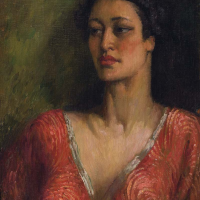6. NORMAN LINDSAY

The act that the figure of Rita looms large in the oeuvre of Norman Lindsay is no small endorsement, given that the artist worked with approximately 130 models during his highly productive period of the 1930s and 1940s.1
Writing to his biographer, Norman Hetherington, Lindsay stated that during the late thirties, when all the uproar of the twenties had died down, I had the best time of my life. The press left me alone when I ceased to be news. I had no exhibitions and sold work through the dealers2
It was during this period that the artist was introduced to Rita Lee, a statuesque Pre-Raphaelite beauty of Spanish and Chinese parentage, whom Lindsay was to feature in a diverse selection of paintings, ranging from theatrical creations such as Crete 1940 to more decorous examples including Rita of the Nineties 1942. Although in Crete Lindsay depicts Rita as an imposing full frontal nude (with her younger brother providing the model for the figure at her left) flanked by a bull and a leopard and surrounded by a crowd of other beauties, in Rita of the Nineties she wears long gloves and a high necked Victorian costume, the bodice of which is adorned with lace.
In contrast to Crete, where the model gazes commandingly at the viewer, the current work (which is thought to have been painted in the same year) exhibits a more contemplative aspect. In Rita c1940, the artist skilfully renders the contours of the models figure and the shimmer of the garment hugging it, taking the opportunity to demonstrate his prowess in translating the folds of exotic fabrics and other materials into oil paint.
The current work exudes a sense of stillness and assurance, demonstrating Ritas capacity for conveying emotion, a quality it seems that the artist appreciated as much as her striking appearance:
One girl, named Rita, that I painted many times during my attack on oils, was the only one I got results from. She was a quiet, simple creature, very reticent, but she always expressed the emotion of any pose I put her in.3
Although the oldest extant Norman Lindsay oil is believed to be one he executed at the age of ten,4 his first concentrated forays into the medium as an adult began in the mid-1930s while he was residing at his studio at 12 Bridge Street in Sydney. He was to remain there until the early 1940s, with the working relationship between the artist and his model in the main being confined to what they referred to as their Bridge Street days. Rita was first depicted in Two Models of 1936,5 when she was in her late teens, and convention has it that she worked for Lindsay until her marriage in 1943, although she may have continued to do so afterwards. Their friendship was to last until the artists death in 1969.
Lindsay valued not only Ritas versatility, but also (to borrow a phrase from Arthur Conan Doyle) her grand gift of silence,6 stating that She was not a talker. Shed sit aloof and reticent behind her mask. She was a perfect model for oil painting,7 her reticence being one of her best assets. Chattering models are a nuisance.8
Whether the success of their working relationship was due to the models striking looks, her capacity to convey emotion or her ability to let the artist focus on the task at hand (or a combination of all three), as the artists granddaughter Helen Glad has noted, Norman Lindsay never did a bad painting of Rita, which is why they are worth so much more than the others.9
1. Bloomfield, L., Norman Lindsay: Oil Paintings 1889-1969, Bungendore, Odana Editions, 2006, p.3
2. Norman Lindsay, letter to Norman Hetherington, March 1969, quoted in Bloomfield, p.124 However, the author states that despite the artists assertions to the contrary, he did exhibit in the 1930s.
3. Norman Lindsay, letter to his sister, Mary Lindsay, undated circa 1957, quoted in Bloomfield, p.186
4. The work is titled Little Roundhead Soldier 1889. See Bloomfield, pp. 22-23
5. ibid., p.92
6. Sherlock Holmes to Dr Watson in The Man with the Twisted Lip, Sherlock Holmes: The Complete Stories, Wordsworth Editions, Hertfordshire, 2006, p. 526
7. Bloomfield, p. 156.
8. Norman Lindsay, letter to Norman Hetherington, late 1959, quoted in Bloomfield, p. 178.
9. Helen Glad quoted in Andrea Dixon, Well-Rounded Figures, The Sun-Herald, 21 November 1999, p. 69.
Anne Phillips BA (Hons), MA